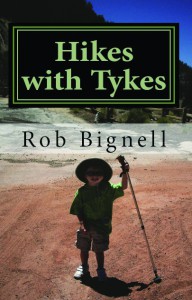
In this Q&A, first published in EcoParent, Robin Fraser asks Hikes with Tykes author Rob Bignell about the pleasures and the benefits of nature-walking.
Q: Your book is quite comprehensive, but the tone is fun and accessible. Congrats! Was it what you originally set out to do?
A: I wanted to write something that parents and other caregivers could just pick up and find useful about hiking with children. I’m a big advocate of getting out and enjoying nature, and even for babysitters and nannies during the day, if you have a few hours to spend with a child, and a stroller, why not be outside, get into parks, start small. You can see the benefits of getting outside, and enjoying the wild.
Q: Something that stood out and made me laugh was the early subtitle: Attitude Adjustment. Tell us more…
A: Yeah! That was the first thing that I discovered. Before I was a parent I would do a hike that was 12 miles…as soon as I had my son, I thought, “Wow. I can’t do that anymore, I can’t go back-country hiking anymore because there’s no way to take him with me.” And then I thought, you know, if parents can strap their kids in and take them to the mall, there’s no reason we can’t just start small and go for a long nature walk.
So I strapped him into a carrier and took off, and I thought I was very clever, you know, I brought a diaper, and I brought a bottle with me, and he was only like 4 or 5 months old. We’re out there on the hike, and of course he filled his diaper, and I realized I didn’t have a pad to lay him down on, that I was going have to take off my sweatshirt because it was spring, there was nothing but the cold wet leaves to lay him down on… then I realized I had no wet wipes with me, fortunately I improvised. Then he downed the bottle, and I didn’t bring anything else, so then he was hungry, and, I mean, it was so stupid! I had to totally readjust my thinking…
What was happening to me then, as with a teething baby you know, [is] that they have needs about every ten or fifteen minutes or something, especially at that young an age, and I began to realize that I couldn’t just walk, because I was used to keeping a pace. So I thought, ok, I have to go at your pace. And once he was able to walk, and get down, I realized that it was going to be even slower, because to him he was discovering everything, I mean he would spend a half hour watching a bug cross the road, and that was the part of the experience that he would talk about the next week, and that if I’m not doing that, that maybe there’s something wrong, then maybe I should stop and look at the bug…it made it more pleasurable for both he and I, and then it just got better and better.
You know, as he gets older, when he becomes a teen, I’ll have to switch it around a bit, because when you’re a teen then the destination becomes important, and the journey is just part of getting there much like as an adult, but as a young child it’s the total opposite, it’s the journey that matters. It doesn’t even matter if you reach the destination. All that matters is that you went out together, you spent time together, you had fun; you bonded together.
– Advertisement –
Q: What are some of your favourite spots to go?
A: Oh, I wish I had my laptop with me! Off the top of my head, I love going around the Great Lakes. Thunder Bay, and some areas around there. And of course in British Columbia.
Q: What are some red flags when choosing destinations with kids in mind?
A: Avoid swampy areas. Feet get wet, and there are tons of mosquitoes. And don’t be too destination oriented. Some hikes are too boring for a child if there is a fantastic lookout at the end, but nothing to see along the way.
Q: Any tips for packing light?
A: Yeah, absolutely. Only bring what you absolutely need. And only bring the amount that you really need. Bring a small camera, don’t lug heavy equipment around. If you buy gear, buy gear that makes packing easy. And if the weather is nice, and you’ve driven somewhere, leave your change of clothes in the car.
Here are some useful tips culled from Bignell’s book to guide you:
- Children will need clothing suited to the environment, such as a brimmed hat and sturdy shoes. Consider layers of clothing that can be added or removed to adjust to the climate.
- Remember that just about anything can interest a child on a hiking trail- take the time to explore and don’t push to reach a destination.
- Don’t let children run too far ahead. To avoid getting lost or hurt, they should always remain within eyesight.
- A good first-aid kit is essential. Be sure to include sunscreen and bug-repellent too.
- Don’t turn a fun day into a forced march by going too far for little legs. Many suggest about one kilometer per year of age (starting at three years old) as a very rough estimate. Better to do too little and leave them wanting more!
- If your children are small, bring a good child carrier so that they can take a load off when necessary.
- Pack light snacks and water for everyone.
To see the print version of this story, and to read more stories like it, check out EcoParent magazine.

Discover more from thegreenpages
Subscribe to get the latest posts sent to your email.
